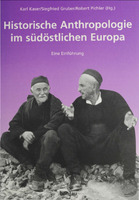Historische Anthropologie im südöstlichen Europa
Eine Einführung
Author(s)
Gruber, Siegfried
Pichler, Robert
Kaser, Karl
Collection
Austrian Science Fund (FWF)Language
GermanAbstract
The beginnings of historical anthropology as a transdisciplinary project have to be located in the 1970s. However, in this part of the world it is still considered as a young project. This seems to be the main reason for not having yet developed a common understanding about its aims, methods and core contents. There is also no unanimity about the perception, advocated in this volume, that historical anthropology does not represent a new scientific discipline but an altered understanding of history as a discipline as a whole for the purpose of transdisciplinarity. The intention of the endeavor ‘historical anthropology’ is far from questioning established disciplines such as the historical scholarship but to put man in its historical contingency and cultural complexity into the focus of research and academic teaching. Since the temporal dimension does play a central role anthropologically oriented historical scholarship occupies a specific position in this project. Historical anthropology is comprehended here as integration of disciplines in the sense of a comprehensive science of the human being.
Historical anthropology conducted in a rather peripheral region such as Southeastern Europe or the Balkans due to its specific historic development and cultural features is confronted with partly other challenges and has partly different aims compared with Western or Central Europe, for instance, which is reflected in the composition of the present volume. It consists of five parts. The first one addresses migration and adaption strategies, the second one gender relations and stages of life. The third one deals with the complex relationship of geographic features such as mountains and sea, and the human being. The fourth part is devoted to law and disciplining, and the concluding one to identities. The authors are either directly affiliated with Centre for Southeast European History and Anthropology at University of Graz or colleagues from abroad with whom the Centre has intensive collaboration. Die bislang vor allem ethnozentrierte Perspektive auf Geschichte und Kultur Südosteuropas hat viel zu den unübersehbaren Spannungen in der Region beigetragen. Eine historisch-anthropologische Perspektive kann dem Entscheidendes entgegensetzen und ethnozentrierte Blicke auflösen.
Dieser erste Überblick über Themenfelder einer Historischen Anthropologie im südostlichen Europa hat Einführungscharakter und weist gleichzeitig auf Forschungsperspektiven hin. Dargestellt werden u. a. folgende Themenfelder: Wanderungen und Anpassungsstrategien; Geschlechterbeziehungen und Lebensphasen; das Gebirge, die Stadt und das Meer; Recht und Disziplinierung; Identitäten. Die Beiträger und Beiträgerinnen stammen sowohl aus Ländern des westlichen als auch des südöstlichen Europa.
Keywords
historical anthropology; Southeastern Europe; migration; gender relations; generational relations; environment; family; kinship; youth and age; religion; historical urban anthropology; Historische Anthropologie; Religion; Lebensphasen; Geschlechterbeziehungen; Südöstliches Europa; Balkanhalbinsel; Osmanisches Reich; SüdosteuropaDOI
10.26530/oapen_471370ISBN
9783205771258OCN
607062316Publication date and place
2003Grantor
Imprint
BöhlauClassification
Anthropology


 Download
Download